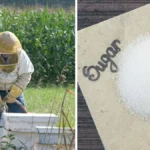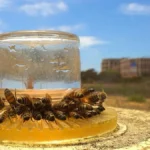Winter bee feeding is an important part of ensuring your hives make it through the winter and emerge strong and healthy in spring. In this article, we review a few tricks to get your bees through winter. If you search on the internet you will find many a winter bee feeding recipe. We review a few that work.
In a colder winter, where temperatures are below freezing for prolonged periods of time – bees require significant stores to make it through the winter. Typically in fall, we would use a number of liquid feeding methods to ensure that our hives have sufficient stores in their honeycombs to sustain the winter cluster.
Due to the physicochemical properties of sugar solutions, it is undesirable to feed bees liquid feed as temperatures drop, and we shift over to supplemental feeding methods that use sugar in the solid form. In this article, we will explore a number of solid sugar feeding options to allow you to keep your bees as healthy as possible in winter.
The Advantages Of Solid Sugar Feed For Bees
When we look at winter bee feeding, we are aiming to provide bees with sugar in such a way that we can feed them and not damage the hive. When bees metabolize sugar they produce carbon dioxide and water as by-products. Hence bees eat sugar and derive energy and produce two problematic by-products.
Condensation/Moisture Control
The biggest advantage of using a solid sugar feed is that moisture condenses in the sugar. Sugar is slightly hygroscopic – this means that moisture is attracted to it. It is also heavy, and has mass – hence it will tend to be slightly cooler than the cluster of bees – this means water will condense into the sugar.
The moisture dissolves sugar, which the bees can then eat. In this way, our solid sugar feeder removes moisture from the air in the hive. Moisture control in a hive is a very important part of ensuring beehive survival. Ventilation helps to remove some moisture and carbon dioxide. The sugar helps to remove even more moisture.
Winter Bee Feeding Recipe(s)
There are a number of different methods by which we can use dry sugar for winter bee feeding. We have already reviewed how to make a candy board and the Mountain Camp method of dry feeding.
No-Cook Candy Board For Bees
Time is money – or for us beekeepers – time is honey. We want all management decisions and operations in beehives to take the minimum amount of time. In this regard, there are methods to make candy boards where you cook the candy – this takes a bit of time and energy. You can achieve the same results with a simple candy board made by mixing sugar and water and allowing it to set naturally.
Sugar Cakes For Bees
An alternative to making candy boards, or the Mountain Camp method of sugar feeding is to make simple sugar cakes. Each person has their own method to make these. My method is normally just as a quick little pick-me-up supplement. I mix six parts of sugar with one part of the water in a bucket using a shovel.
Once the sugar is uniformly damp, I scoop it out into trays lined with waxed paper at the base. Tamp the sugar flat with a smooth plank. You can then let the sugar set for two to three days – it sets rock hard. Once set, remove it and break it into pieces of the size you require. Place the pieces over the top bars in the hive.

I have seen some recipes on the internet that do not use wax paper on the base of the cakes – I find that with my bees this results in the bees dropping sugar on the bottom board. On a warm day, you can find heaps of sugar in front of the hive that is being carted out -this is a waste. If you use wax paper, they are more likely to actually eat the sugar.
A Note On Pollen In Sugar Cakes
I have seen a number of notes on the internet where people suggest including pollen substitute or pollen in their winter bee feeding recipe. This just seems to be a bad idea to me. With the small hive beetle now being more widespread, pollen patty plus sugar just equals trouble. You really do not want to be breeding beetles in your hives in the middle of winter.
Sugar Beet Sugar Versus Cane Sugar
I have also seen some heated debates about sugar beet versus cane sugar for feeding bees. Both sugars are chemically identical to a large extent. Sucrose is the dominant sugar in both. There are a few small variations in the rate of incorporation of carbon isotopes into the two sugars based on the fact that Sugar Beet has C3 photosynthesis and Sugar Cane uses C4 photosynthesis. But this has no effect on sugar at all.
In late fall feeding, beekeepers often have a choice between granular sucrose and liquid syrups. Syrups made from corn, such as corn syrup and high fructose corn syrup are quite different from sucrose.
These syrups are made by the enzymatic conversion of corn starch to glucose. If another enzyme is used as well, you can produce high fructose corn syrup. HFCS is of interest to bees as it contains glucose and fructose without their need to invert it. Hence they can pack it away quickly into honeycomb. There are certain arguments in favor and against these syrups and it will be up to you to find out what works for you in your fall and winter feeding regime.
We hope this article has helped you evaluate some options for your winter feeding regime. Whether you choose candy boards, the Mountain Camp method, or sugar cakes, you will help your bees control their moisture in the hive. And the byproduct is fed for them! Enjoy and share!
Read more about: How To Keep Bees Alive In Winter
Winter Bee Feeding FAQs
Why is winter feeding important for bees?
Winter feeding ensures that bees have enough food to survive the cold months when natural foraging is limited, helping them emerge strong in the spring.
What types of food should I feed bees in winter?
Solid sugar feeds, such as sugar cakes, candy boards, or the Mountain Camp method, are common in winter as they help with moisture control and provide energy.
Can I use liquid feed during winter?
Liquid feed is generally discouraged in freezing temperatures as it can increase moisture inside the hive, which may harm the bees.
What is a candy board, and how does it work?
A candy board is a solid sugar feeding method that provides bees with a hardened sugar block, allowing them to eat the sugar as it absorbs moisture from the hive.
How do sugar cakes help with moisture control in the hive?
Sugar is hygroscopic, meaning it absorbs moisture from the air, which reduces condensation inside the hive and prevents the bees from getting damp.
Should I include pollen in my winter bee feeding recipe?
Including pollen or pollen substitutes is generally discouraged in winter feeding, as it can attract pests like the small hive beetle.
What’s the difference between using cane sugar and beet sugar for feeding bees?
Both sugars are chemically similar and contain sucrose, so either can be used for winter feeding. The key is to avoid additives and use pure sugar.
What is the Mountain Camp method for winter bee feeding?
The Mountain Camp method involves placing dry sugar directly on a piece of newspaper over the top bars of the hive to provide food and moisture control.
How do I make sugar cakes for winter feeding?
Sugar cakes are made by mixing sugar and a small amount of water, letting it set in a tray until it hardens, then breaking it into pieces to place in the hive.
Can I use high fructose corn syrup (HFCS) for winter bee feeding?
While some beekeepers use HFCS for fall feeding, it’s generally not recommended for winter feeding due to the risk of crystallization and fermentation at lower temperatures.

Dr. Garth A. Cambray is a Canadian/South African entrepreneur and beekeeper with 28 years of experience in apiculture and specializes in adding value to honey. His Ph.D. research developed a new advanced continuous fermentation method for making mead that has resulted in a number of companies globally being able to access markets for mead. His company, Makana Meadery, exports honey mead to the USA where it is available to discerning connoisseurs. He has also developed technologies to commercially manufacture organic honey vinegar in Zambia for export globally. He holds a few patents globally in the ethanol industry and believes in technology and knowledge transfer for human development and environmental sustainability. One of his proudest achievements is the fact that the wind farm he started at one of his old apiary sites has essentially made his hometown carbon neutral.






